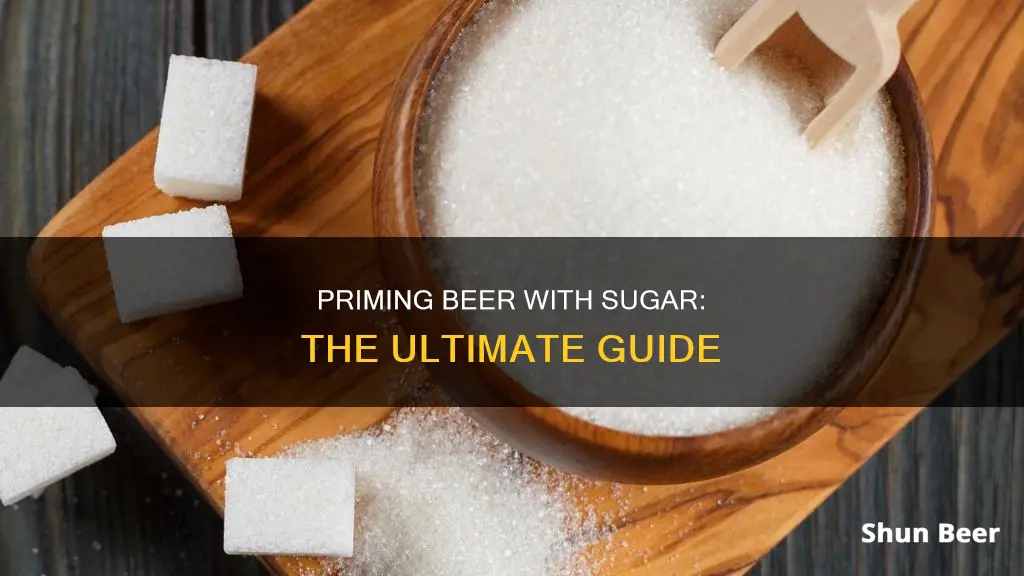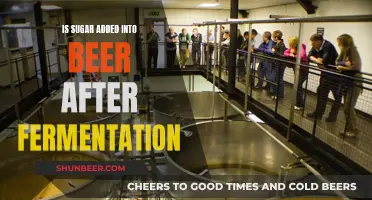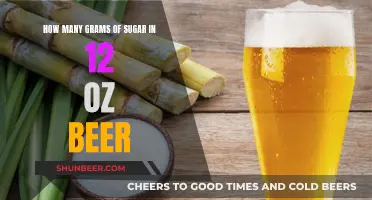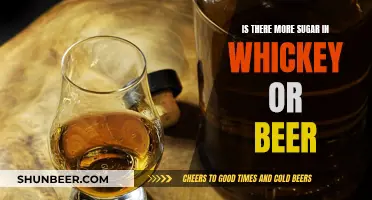
Carbonation is an essential part of the beer-making process, adding fizz and helping to carry volatile aroma compounds to the nose, giving beers a distinct smell. There are two main ways to carbonate beer: priming sugar and force carbonation. This article will focus on the former, explaining how to prime beer with sugar to achieve the perfect level of carbonation.
What You'll Learn

Carbonation: the process that follows primary fermentation
Carbonation is an essential step in the beer-making process, giving beer its characteristic fizz and helping to preserve it. This process follows primary fermentation and can be achieved through two main methods: priming sugar and force carbonation. This response will focus on the priming sugar method, a popular choice for homebrewers.
Priming is the process of adding sugar to beer before bottling or kegging to create carbonation. The sugar is consumed by the remaining yeast in the beer, which then produces carbon dioxide as a byproduct. This carbon dioxide is trapped, creating the desired bubbles in the beer. The amount of sugar added can significantly impact the final product, with too much potentially resulting in over-carbonation and too little leading to under-carbonation.
There are several types of sugar that can be used for priming, each with its unique flavour profile and effect on the beer. Common choices include table sugar, corn sugar, honey, and malt extract. Table sugar, or sucrose, is inexpensive and readily available, but it can contribute a slight sweetness if used in excess. Corn sugar, or dextrose, is another popular option as it is very soluble and easy for yeast to digest, with minimal impact on the beer's flavour.
To ensure consistent carbonation levels, it is crucial to dissolve the priming sugar thoroughly in boiling water before adding it to the beer. The amount of sugar required depends on factors such as the style of beer, the desired carbonation level, and the temperature of the beer at bottling. A simple formula or an online priming calculator can be used to determine the precise amount needed.
The priming process itself can be done through several methods. One approach is to use a large syringe to add the priming sugar solution directly to each bottle, ensuring equal distribution. Another method is to add the sugar directly to the fermenter and agitate it to mix, although this may stir up excess yeast that can affect the flavour. A third option is to add the dissolved sugar to a second vessel and then rack the beer into it before bottling, but this method is more time-consuming and carries a higher risk of oxidation.
Overall, carbonation is a crucial step in the beer-making process, and it requires precision and patience to achieve the desired results. By understanding the role of priming sugar and following the recommended procedures, homebrewers can create a well-carbonated beer with the right amount of fizz.
Sugar in Beer: Pint-Sized Sweetness Explored
You may want to see also

Priming sugar types: corn sugar, table sugar, dry malt extract, and honey
When it comes to priming beer with sugar, there are several options available, each with its own unique characteristics and effects on the final product. Here is an in-depth look at four of the most commonly used priming sugars: corn sugar, table sugar, dry malt extract, and honey.
Corn Sugar:
Corn sugar, also known as dextrose, is a popular choice for priming beer. It is used to create a priming solution at bottling, which produces carbon dioxide (CO2) and helps to carbonate the beer. Corn sugar is easily consumed by yeast during fermentation, which then converts it into CO2. It can also be used to boost the alcohol by volume (ABV) of the beer; approximately 3.4 ounces of corn sugar per gallon will increase the ABV by 1%.
Table Sugar:
Table sugar, or sucrose, is another viable option for priming beer. It is similar to corn sugar in terms of functionality, as it is also converted into CO2 by yeast during fermentation. Table sugar is known for its ease of measurement and consistent fermentability. It is generally more readily available and affordable than other priming sugars.
Dry Malt Extract (DME):
Dry malt extract is a convenient choice for brewers as it simplifies the beer-making process. It reduces the time required to make wort, which is the sweet liquid extracted from malted barley or other grains during the brewing process. DME is created by taking the wort and removing the water, resulting in a dry, shelf-stable product that can be easily rehydrated for use in brewing.
Honey:
Honey can be used as a priming element for beer, but it is important to note that it may not contribute significantly to the flavour of the final product. The impact of honey on flavour can be subtle, and it is generally recommended to add honey after primary fermentation to assess its influence on flavour independently from priming. Honey has variable fermentability, making it tricky to determine the resulting carbonation levels accurately.
Sugar Cubes in Beer: How Many is Too Many?
You may want to see also

Calculating the amount of priming sugar
When bottling your beer, you can use a few methods to add priming sugar to carbonate the beer. The amount of sugar used will determine the final level of carbonation in your beer.
One method is to use a syringe to add a priming sugar solution directly to each bottle. This ensures that each bottle has the same amount of sugar, creating consistent carbonation across all bottles. To do this, you'll need to sanitise a small pot and lid by boiling them in water for 5 minutes. Keep 1/3 cup of the boiling water and stir in 2/3 cup (90g) of priming sugar (dextrose) until dissolved. You can increase the amount of dextrose to 3/4 cup for higher carbonation levels. Bring the sugar solution to a boil and then turn off the heat source and let it cool down. Use a large sanitised syringe to draw up the sugar solution. Divide the total volume of the sugar solution by the number of bottles you'll be filling, and add this amount to each bottle before pouring in the beer.
Another method is to add the priming sugar directly to the fermenter and agitate it to mix thoroughly. However, this method requires careful sanitation to avoid compromising the quality of your beer. It may also stir up the yeast, which can contribute off-flavours to your beer if too much ends up in the bottles.
A third method involves adding the dissolved priming sugar to a second vessel and then racking the beer into it prior to bottling. While this method ensures even distribution of the sugar, it is time-consuming and carries a higher risk of oxidising the beer.
Regardless of the method you choose, it's important to store your bottles in a dark area within the recommended temperature range for your recipe for around 3 weeks. This allows the leftover yeast to feed on the sugar and create carbonation.
How to Properly Use Sugar for Beer Carbonation
You may want to see also

Priming sugar conversion chart
To prime beer with sugar, you need to add a priming sugar solution to your bottles of beer. This will create carbonation, which is what gives beer its fizz. The amount of sugar used will determine the final amount of carbonation in your beer.
There are a few different methods for adding priming sugar to your beer. One method is to use a large syringe to add the priming sugar solution directly to each bottle. This helps ensure equal sugar quantities in each bottle, but you need to be careful to sanitise the syringe properly. Another method is to add the priming sugar directly to the fermenter and agitate to mix, but this can stir up the yeast and affect the flavour of the beer. A third method is to add the dissolved priming sugar to a second vessel and then rack the beer into it prior to bottling. However, this method can be time-consuming and may increase the risk of oxidising the beer.
The type of priming sugar you use is up to you. Popular options include corn sugar (dextrose), table sugar (sucrose), and dry malt extract (DME). You can also use honey, but this requires a slightly different approach as it can vary in density and composition.
To determine how much priming sugar you need, you can use a priming sugar calculator or a carbonation priming chart. The amount of sugar will depend on the volume of beer you are making, the type of sugar you are using, and your target carbonation level. Here is a priming sugar conversion chart for 5 gallons of beer:
- Corn Sugar (Dextrose): 3/4 cups (6 ounces or 113 grams)
- Table Sugar (Sucrose): 2/3 cup (5.3 ounces or 150 grams)
- Dry Malt Extract (DME): 1 1/4 cups (181 grams)
- Honey: 1/2 to 1 cup
It's important to note that these measurements are just a starting point and may need to be adjusted to hit your target carbonation level. The specific gravity of honey can also affect the amount needed for priming.
Beer and Blood Sugar: What's the Connection?
You may want to see also

Priming methods: syringe, direct to fermenter, or second vessel
There are several methods for priming beer with sugar, each with its own advantages and disadvantages. Here is an overview of three common methods: priming with a syringe, direct to the fermenter, or using a second vessel.
Priming with a Syringe
This method involves creating a priming solution by cooking water with a measured amount of sugar. The solution is then drawn into a syringe and injected into each bottle of beer. This approach ensures precise control over the amount of sugar added to each bottle, which is especially important for creating consistent carbonation levels. However, it can be time-consuming and may not be practical for priming a large number of bottles.
Direct to Fermenter
Another approach is to add the priming sugar directly to the fermenter before bottling. This method is straightforward and avoids the need for a separate vessel or syringes. However, it does not allow for precise control over the sugar distribution, and there is a risk of disturbing the sediment at the bottom of the fermenter.
Second Vessel
A third option is to transfer the beer to a second vessel, such as a bottling bucket, and add the priming sugar to that. This method allows for better control over the mixing process and reduces the risk of disturbing the sediment. However, it requires additional equipment and can be more time-consuming.
Regardless of the chosen method, it is crucial to use the correct amount of priming sugar to avoid over-carbonation or under-carbonation. Online calculators and carbonation charts can help determine the right amount of sugar needed for the desired level of carbonation.
Red Stripe Beer: Sugar Content and Nutritional Facts
You may want to see also







